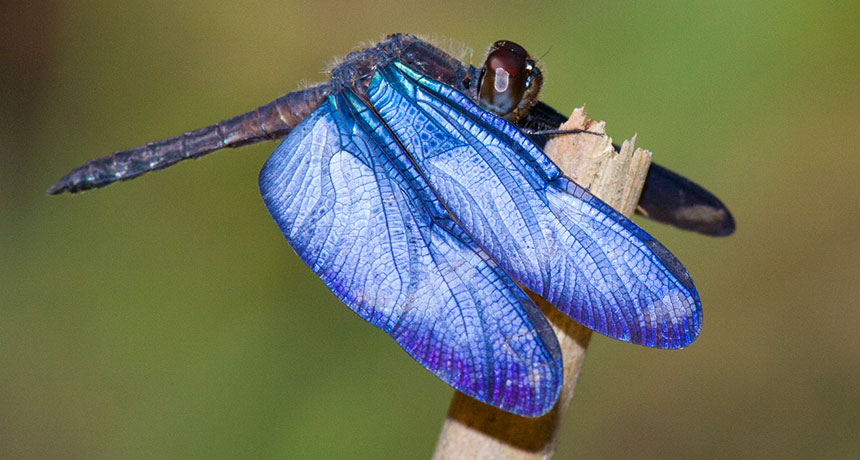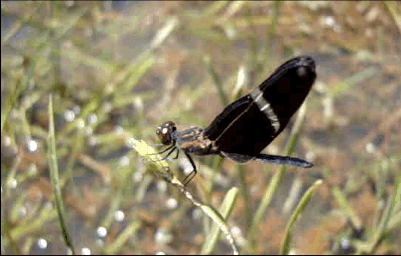Could a dragonfly’s wings be alive — and breathing?
Surprising microscope image hints at breathing equipment in the wing of a morpho dragonfly

These are the shimmering blue wings of a morpho dragonfly.
GREG LASLEY/INATURALIST.ORG (CC BY-NC 4.0)
By Susan Milius
An adult insect wing is basically dead. Most of it is dried up, like a dead leaf. Only a little bit — the skinny dark lines called veins — have living, breathing parts inside. Or so Rhainer Guillermo Ferreira thought. So what were those little pipes that looked like breathing tubes doing in the dried parts of dragonfly wings?
Guillermo Ferreira was stunned. The pipes looked like tracheal tubes. They are what carry oxygen to living tissues in insects. So why would tissue that was supposed to be dead need to breathe? That’s what this insect biologist — or entomologist — working at Kiel University in Germany was curious to know.
So he asked another insect biologist to take a look. This colleague, too, was “shocked.” They now brought in yet a third entomologist. Still, there was shock all around.
The shimmering blue wings of male Zenithoptera (Zeh-neh-THOP-tur-uh) dragonflies might be unexpectedly alive, Guillermo Ferreira now suspects. That bold idea will take some testing. For now, though, he and his colleagues suggest the tubes are an unusual breathing system. It would be the first of its kind in the main part of any insect wing, Guillermo Ferreira says.
His team shared its surprise findings in the May Biology Letters.
Insect wings start out alive. But as the creatures morph into adults, cells between veins in the wings die. These dried-out zones can be clear. Some may become covered in a patchwork of color bordered by the vein network. This can create a system that resembles glass pieces in a cathedral window.

The veins have their own inner life-support system. It includes respiratory tubes, nerves and such. But researchers thought the rest of an insect wing would be no more in need of oxygen than a person’s toenail clippings.
The new data are now causing some scientists to rethink this.
Living, breathing wings might help explain how South America’s four or five species of morpho dragonflies make such a complicated blue color, says Guillermo Ferreira. (He’s now at the Federal University of São Carlos in Brazil.) Blue pigment is rare in nature. And it’s nowhere on these wings. Instead, the wings look blue because a living layer cake of structures plays tricks with light. Perhaps they’re able to grow so complex because they get plenty of oxygen, he says.
One dragonfly that engages in such color trickery is the male Zenithoptera lanei. The tough inner layers of its wings contain nanoscale spheres sandwiched between blankets of black-pigment-filled nanolayers. (Nanoscale structures are those that are on the order of a billionth of a meter in size.) This setup can make blue light bouncing off of wings easy to see. On top are two more light-trick layers. Each of these is made of wax crystals. The uppermost crystals, Guillermo Ferreira finds, are shaped “like little leaves.” At the same time, the structures make other colors get in the way of each other, cancelling each other out.
Better blues might help a male scare off his rivals. And that would give him an advantage in competing for breeding territory around palm tree swamps. Guillermo Ferreira often sees a male dragonfly “rushing toward the rival, grabbing the wings, biting the wings and then sometimes biting the head.”
That leaves the male with a good chance of winning a mate, he says.







